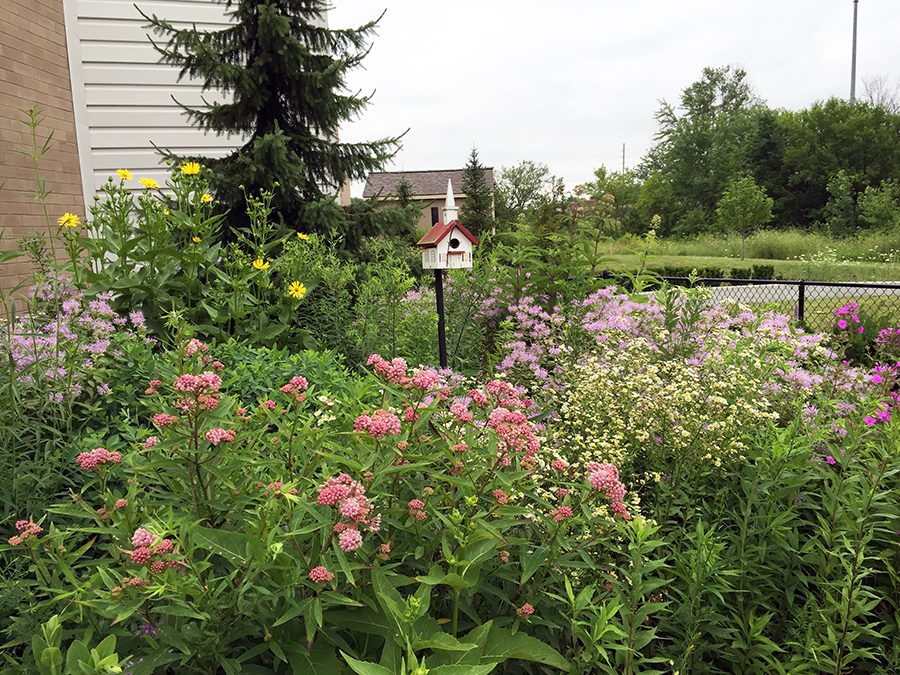The Indiana Native Plant Society is tackling head-on the need to bring the entire community on board with the importance of using native plants in the landscape. A beefed-up Landscaping with Natives team is working on several fronts to make this so, as outlined below. Your participation is welcome by emailing landscape@indiananativeplants.org.
Note: Please do not expect INPS to assist with your landscape plans on a volunteer basis. We support those who make a living by specializing in landscaping with native plants.
If you have a garden project in mind, we recommend that you join INPS and get to know members of your regional chapter, who may be happy to share their expertise and experience. Our Grow Indiana Natives program lists certified landscape designers who can help with formal plans. In the meantime, we encourage you to explore the many resouces provided on this website.
Team Charge
Consistent with our strategic plan, we want to establish INPS as a highly visible champion for native plants and biodiversity, develop an effective messaging strategy, and explore new vehicles and technologies to educate, inspire, and motivate target audiences. Goals specific to landscaping with native plants include:
1. Make Quality Information Available and Accessible to Gardeners/Landscapers
- Inventory, evaluate, and improve what’s available on INPS website and in INPS outreach brochures.
- Seek out other resources (organizations, books, agencies, etc.) to supplement.
- To help gardeners get started, develop “starter lists” of five to ten landscape-worthy native plants for different site characteristics.
- Work with Purdue to remove invasive species recommendations from their existing publications.
- Determine how best to address the most common questions posed by would-be native plant gardeners.
- Propose brochures, workshops, social media use, and outreach campaigns to reach specific target audiences.
- Make the case for attracting insects, not just birds, and promote insect watching as a pastime.
- Promote the message that people who garden with natives are champions for biodiversity.
2. Provide Examples of Well-Designed and Maintained Gardens that Incorporate Native Plants
- Develop simple vignettes that show how specific native plants can be combined in controlled landscape settings (e.g., rain gardens, erosion control, perennial gardens, commercial sites).
- Post worthy landscaping example sites on the website that people can visit year-round to appreciate how native plants develop through the seasons.
- Organize an effort to gather photographs of well-designed native plant vignettes to show people the possibilities.
- Support chapters in organizing garden tours featuring native plants.
- Provide appropriate signage to visibly reward gardeners or other entities who use native plants well and to showcase their gardens (e.g., popup garden hosts, government buildings).
- Enlist chapters in maintaining worthy but perhaps neglected native landscapes in their regions (e.g., school rain gardens, neighborhood prairies, adopted medians).
3. Reach Out to Municipalities, Utility Companies, Real Estate Developers, and Homeowners Associations to Improve the Acceptance of Native Plants
- Pinpoint areas of greatest degradation in the state (“red zones”) to prioritize efforts.
- Review city planning commission pre-design lists of acceptable plants; point out invasives to avoid and suggest appropriate native alternatives
- Review municipal or regional weed ordinances to find worthy models and circulate widely.
- Work with utility companies to plant appropriate natives under telephone wires, etc.
- Encourage INPS members to brief their homeowners associations on using native plants to improve biodiversity, discourage Canada geese at pond edges, etc.
- Investigate grants that might pay for native plantings in neighborhoods.
- Partner with Southern Indiana Cooperative Invasives Management Initiative (SICIM) to benefit from the work they are doing in reaching out statewide.
- Reward compliant organizations with favorable publicity pointing out the economic and environmental benefits of native plants.
- Engage with real estate developers on the benefits of biodiversity; provide a forum for agents dealing with properties that preserve native plantings (e.g., member gardens).
- Present at organizational conferences, and invite attendance at INPS Annual Conference, perhaps launching a scholarship program.
4. Expand and Manage “Grow Indiana Natives” Retail Incentive Program
- Maintain the Grow Indiana Natives website.
- Seek out and evaluate plant sellers and designers.
- Award Certified Native Plant Designer certificates.
- Develop and fund in-store materials that promote native plants.
- Arrange to fulfill requests for materials promoting native plants.
- Engage Chapters in monitoring specific vendors and designers in their regions.
- Develop rack cards and banners to promote the program at conferences (e.g., Green Expo).
- Explore how to teach sellers what is native and what is invasive.
- Promote the program with the gardening public and INPS members to create demand that will reward sellers for stocking native plants.

